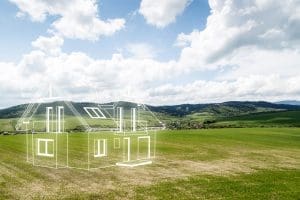This year first-time home buyers continue to face daunting barriers to buying land. With mortgage rates stabilizing at 6.75% and down payment assistance programs expanding under the Biden administration’s $25 billion affordable housing push, many are exploring alternatives to traditional turnkey homes. One “outside of the box” option is buying land outright. Can first-time home buyers buy land in 2025? Whether for building a custom dream home, investing in rural acreage, or securing a plot in a developing subdivision, land ownership offers flexibility and potential long-term gains. However, it’s not without hurdles like financing complexities, zoning restrictions, and hidden costs.
The RefiGuide published this article to explore first-time home buyers eyeing land, the feasibility, pros and cons, financing opportunities, and practical steps for to get approved in 2025 . We’ll also review several American case studies, highlighting successes and lessons learned. In an era where 70% of millennials prioritize sustainable living (per a 2025 Zillow survey), buying land aligns with desires for eco-friendly builds and self-sufficiency. Yet, with land prices up 8% year-over-year to an average $3,000 per acre nationally, due diligence is key. Let’s break it down.
Why First-Time Buyers Might Choose Land

Land buying appeals to first-timers for its customization potential.
Unlike purchasing a dated starter home requiring $20,000 in immediate repairs, raw land lets you design from scratch—think solar panels, off-grid features, or ADUs for rental income.
In high-cost urban fringes like Austin or Denver, vacant lots offer a foothold where built homes are unaffordable.
Rural areas, bolstered by remote work trends, see land sales boom 15% in 2025, per USDA reports.
Pros abound: Lower entry costs (a 1-acre suburban lot might run $50,000 vs. $300,000 for a house), equity building through appreciation (land values rose 10% in the Sun Belt last year), and tax perks like deductions for development loans. Environmentally, it supports regenerative farming or tiny homes, appealing to eco-conscious Gen Z buyers. A 2025 Forbes analysis notes that land can hedge against inflation, with average returns of 7-9% annually.
However, cons loom large. Land doesn’t generate immediate income, delaying mortgage payoff. Utilities (water, septic, electricity) can add $10,000-$50,000 upfront, and building codes vary wildly—zoning might prohibit your tiny house vision. First-time home buyers often underestimate permitting delays (6-12 months) and interest rates on land loans (1-2% higher than mortgages, at 8-9%). Without a home’s rental potential, carrying costs like property taxes (1-2% of value) strain budgets. West Capital Lending warns, “Land is an investment in potential, not instant gratification.”
Financing Options for First-Time Land Buyers
Securing funds is the biggest question: How do first-timers finance land? Traditional mortgages don’t apply to vacant plots, but alternatives exist.
Land Loans: These short-term (1-5 years) loans from banks or credit unions cover 20-50% of the purchase price, with rates at 7-10% in 2025. Down payments hit 20-50%, reflecting lender risk—vacant land is harder to foreclose on. SBA 504 loans, for commercial intent, offer up to 90% financing at fixed rates around 6.5%, ideal for future builds.
FHA and VA Loans: First-timers shine here. FHA Title II loans finance land plus construction (up to $498,257 limit), with 3.5% down if building within 12 months. VA buyers (veterans) get 0% down on land in designated areas, per 2025 VA guidelines. Both roll into a single mortgage post-build.
USDA Rural Development Loans: For non-urban plots, these guarantee 100% financing at 6.75% rates, targeting first-timers in eligible zones (90% of U.S. rural areas). No down payment required, with income caps at 115% of area median.
Grants and Assistance: Programs like HUD’s HOME Investment Partnerships provide up to $20,000 for low-income buyers, while state initiatives (e.g., California’s CalHFA Land Trust) offer forgivable loans. Crowdfunding via GoFundMe or platforms like AcreTrader democratizes access for fractional ownership.
Steps to buy: 1) Research via Zillow or LandWatch for listings; 2) Soil tests and surveys ($500-$2,000); 3) Secure pre-approval; 4) Title search for liens; 5) Close and plan development. Budget 5-10% extra for closing costs. In 2025’s market, consulting a realtor specializing in raw land (via NAR’s directory) is crucial.
Challenges persist: Environmental assessments (Phase I ESA: $2,000+) uncover contamination, and HOAs in subdivisions restrict uses. Bankrate’s 2025 guide stresses: “Verify utilities—off-grid adds $30,000 in solar/well costs.” For first-timers, partnering with builders via turnkey contracts eases the build phase.
Case Study 1: The Custom Build Dreamers (Emily and Jake, 28/30, Portland, OR)
Emily and Jake, software engineers saving for years, eyed Portland’s outskirts amid 2025’s 12% home price hike. Traditional homes averaged $550,000—out of reach on their $120,000 combined income. They discovered a 0.5-acre lot for $80,000 via Land.com, zoned for single-family with city water access.
Financing a USDA loan covered 100% at 6.8%, no down payment needed as first-timers in a rural-eligible area. Challenges? Permitting delayed their modular home build by four months, adding $5,000 in interest. Total build cost: $250,000, rolled into an FHA construction-to-permanent loan. By mid-2025, they moved in, customizing with energy-efficient features saving $200 monthly on utilities.
Outcome: Equity of $100,000 in year one from appreciation. “Land let us build our eco-vision without compromise,” Emily says. Lesson: USDA’s flexibility suits suburban first-timers, but buffer for delays.
Case Study 2: The Rural Investment Pioneer (Marcus, 35, Chattanooga, TN)
Single dad Marcus, a logistics manager earning $85,000, sought stability post-divorce. Chattanooga’s rural boom (land up 15%) drew him to a 2-acre wooded plot for $25,000—affordable vs. $280,000 homes. As a first-time buyer, he used an SBA 504 loan for 80% financing at 7.2%, planning a tiny home for Airbnb income.
Hurdles included septic installation ($8,000) and zoning for short-term rentals, resolved via county appeals. He self-built a 400 sq ft cabin for $60,000 using prefab kits, renting it for $1,500/month by late 2025—covering his $400 land loan payment.
Success: Property value doubled to $100,000, providing a nest egg. “Land was my low-barrier entry to wealth-building,” Marcus reflects. Key takeaway: SBA loans empower investors, but verify rental viability upfront.
Case Study 3: The Subdivision Strategist (Sofia, 26, Raleigh, NC)
Recent grad Sofia, a teacher on $55,000 salary, joined Raleigh’s influx (population +2% yearly). Homes hit $400,000, but a subdivision lot in a master-planned community cost $60,000—pre-approved for builds. As a first-timer, FHA financing with 3.5% down ($2,100) via a Title II loan covered land and a $200,000 spec home.
Issues arose with HOA rules mandating approved builders, inflating costs by $10,000. Utilities were stubbed in, easing setup. She closed in spring 2025, moving into a 1,200 sq ft townhome-style build.
Result: Monthly payments at $1,400 (vs. $1,800 for similar homes), with community amenities boosting resale potential. “The lot secured my spot before prices skyrocketed,” Sofia notes. Insight: Subdivisions simplify for novices, but HOA due diligence prevents surprises.
Is Buying Land as a 1st Time Buyer, Right for You?
Yes, first-time home buyers can—and should consider—buying land if aligned with goals like customization or investment. In 2025’s squeezed market, it offers affordability and control, but demands research, reserves (aim for 6 months’ expenses), and professional guidance. Tools like LandGlide apps aid scouting, while free counseling from HUD-approved agencies demystifies processes. As one Zillow expert quips, “Land is the blank canvas of homeownership—paint wisely.” Weigh your timeline: Short-term? Subdivisions. Long-haul? Rural plots. With smart financing and planning, land can launch your journey from renter to owner, building not just a home, but a legacy.
